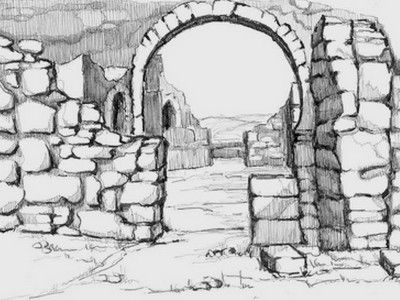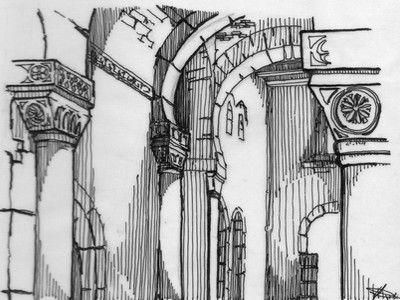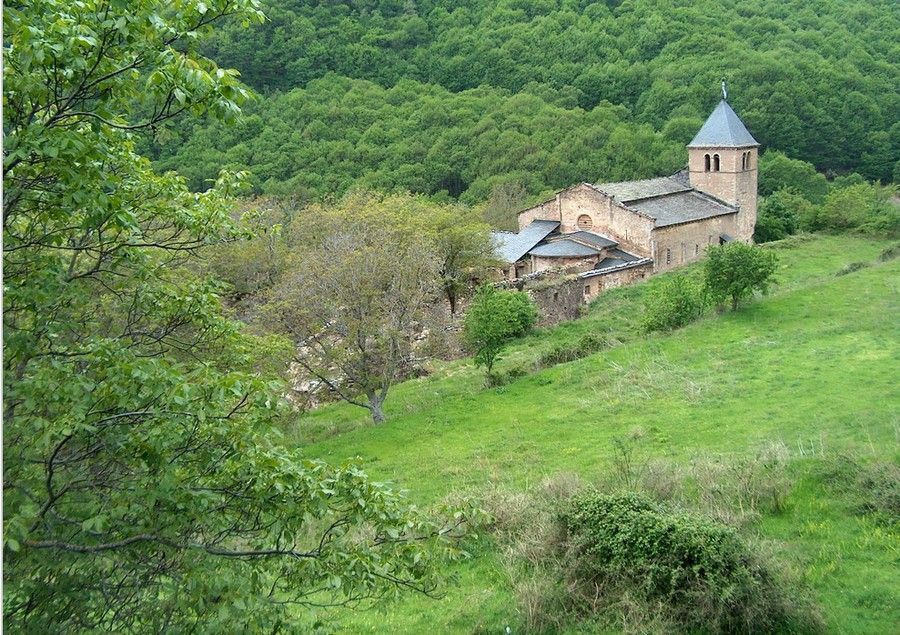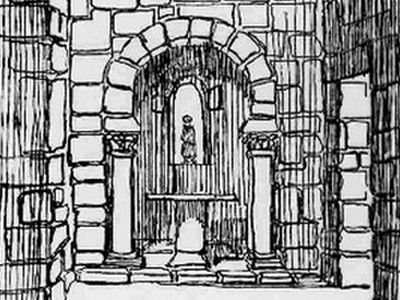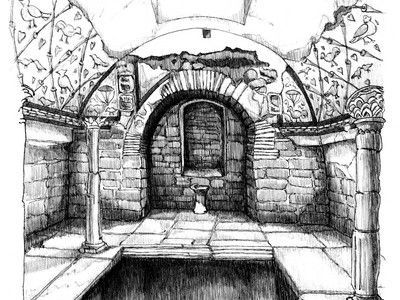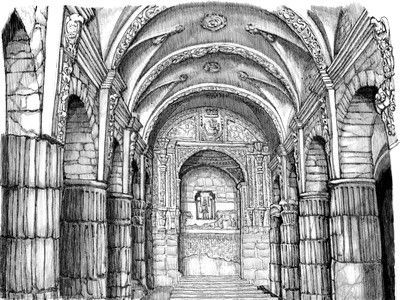Index of files of monuments
SAN PAOLO FUORI LE MURA
Siglo IV -
Constantine I created, on the site where Paul of Tarsus had been buried, a small basilica, consecrated by Pope Sylvester I in the year 324: over time, the building proved inadequate for the multitude of pilgrims and was rebuilt during the century. IV. It is a basilica with a Latin cross plan, divided into five naves separated by four rows of 20 columns, with polychrome marble walls and floors, a semicircular apse and a transept, separated from the central nave by a large arch. The entire church has a magnificent mosaic decoration.
SAN PEDRO DE BALSEMAO
Visigoth - 7th Century - Lamego
Awfully restored; from this church with basilical plan and a square apse, only remains the apse and the initial part of the naves. A triumphal horseshoe arch has also been preserved, very much altered with the restoration, upon columns with late Roman capitals and imposts. It maintains an interesting decoration frieze based on fleurs de lis, waves, secant circles, solar wheels, …
SAN PEDRO DE LA MATA
Visigoth - 7th Century - Toledo
Cruciform church built upon the same plans of St. Comba de Bande and St. María de Melque, though through the remnants that have been found we know it had a much richer decoration, connected with courtier Toledan art. Unfortunately only rests of the walls have survived maybe due to flaws in the laying of foundations upon flat granite soil.
SAN PEDRO DE LA NAVE
Visigoth - 7th Century - Zamora
We are possibly before the most important monument of the whole Visigothic period. With a cruciform plan, with three naves and only one apse, includes the lateral compartments in its original design that we consider were added later. It has also a magnificent sculpted decoration.
SAN PEDRO DE TARRASA
Visigoth - 7th Century - Barcelona
Among the episcopal ensemble of three churches in Tarrasa, this one is located more to the north and it originally had a basilical shape with three naves, that later disappeared starting on the second stretch, although in the restoration in the Romanesque period only the central one was re built, forming like the first stretch of the lateral ones, as in St. Mary, something similar to a crossing
SAN VICENTE DEL VALLE
Visigoth - 7th Century - Burgos
Building with a single nave with a narrower square apse that was later replaced by the present one. It amazes for its two high twin windows with horseshoe arches upon imposts and also for some no less surprising capitals preserved inside, bevelled, properly included in Visigothic sculpture, but also containing some heads with more relief. It was possibly a civil building turned later into a church.
SANTA CECILIA DE ELS ALTAMIRIS
Visigoth - Siglo IV, 6th Century - Lérida
Santa Cecilia de Els Altimiris is an archaeological complex under excavation since 2004 that, in light of the data that has been recovered, is interpreted as a monastic establishment from the 5th-8th and 9th-11th centuries. It is located in the pre-Pyrenean mountain range of Montsec d’Ares (Lleida), on the triangular summit of a foothills 900 m high and in an environment dominated by forests and pastures. All of this is part of the Congost de Mont-rebei Partial Nature Reserve. The complex is made up of a church with a single nave and a semicircular apse surrounded by a series of closed rooms around the sacred building.
SANTA COMBA DE BANDE
Visigoth - 7th Century - Orense
Excellent example of a cruciform church, possibly the first one of its kind ever built. It has the shape of a Greek cross, totally vaulted, a single nave, an apse and a portico forming two simetrical lower and narrower ends, and a crossing nave of equal height forming a balanced ensemble with the main one. It has a lantern covered by a hipped roof over the crossing of both.
SANTA EULALIA DE BÓVEDA
Visigoth - 6th Century - Lugo
An almost square building with double vault, built as a heathen temple dedicated to the God of Water and later reconverted into a Christian church of basilical type. It is very interesting for having the first structural horseshoe arch in Spain and for its Barbarian carved decoration outside and Roman type paintings inside.
SANTA LUCIA DEL TRAMPAL
Visigoth - 7th Century - Caceres
This church, undocumented until 1980, has a body of three verry narrow naves separated by pillars now disappeared, a narrow central choir that connects with the crossing and three independent rectangular chevets very similar to those of St. Juan de Baños. It had lateral porticos with monastic compartments, forming a very complex structure.
SANTA MARGARIDA DEL PRIORAT DE SANT GENÍS DE ROCAFORT
Visigoth - 6th Century - Barcelona
In an environment still undeveloped today, right next to the cemetery of the town of Martorell, the remains of the church currently known by the name of Santa Margarida del Priorat de Sant Genís de Rocafort, of a medieval construction, dating back to its time, are preserved. foundational to Late Antiquity. It is a building formed by a 9 m rectangular nave. wide and with tripartite head, formed by a horseshoe apse inside and trapezoidal outside, with two attached side rooms.
SANTA MARÍA DE LOS ARCOS
Visigoth - 6th Century - La Rioja
It is a three nave basilic with a complex rectangular chevet, built in the 6th century upon a Roman mausoleum of the old metropolis of Tricio the Great, therefore the chevet is facing west. Fragments of huge Corynthian columns were used, upon which Visigothic horseshoe arches in sinter were added.
SANTA MARIA DE MELQUE
Visigoth - 7th Century - Toledo
It is the most conflictive monument in all Spanish Pre Romanesque since though its structure is clearly that of a cruciform church -even the facades recall those of Montelios- its covering system and, above all, its decoration, lead to the Mozarabic period. There are many reasons from the historical point of view as well as from the architectural one that suggest us to include it in the Visigothic period.
SANTA MARIA DE MIJANGOS (R)
Visigoth - 6th Century - Burgos
Basilic with three naves and three rectangular apses with flat sidewall that also has a semicircular apse on the opposite side, that had a burial. The access door is on the southern side and it had a small portico. Of around 20 m long by 10 m wide, it is built in masonry with some reutilized material. There are doubts regarding its dating although a slab indicated its Catholic consecration around the year 601.
SANTA MARÍA DE TARRASA
Visigoth - 7th Century - Barcelona
Among the episcopal ensemble of three churches in Tarrasa, this one would have been the cathedral dedicated to the Virgin Mary. Built in the 7th century upon a previous church, it was a three nave basilic with an apse. Only the apse, the central nave and the first stretch of the lateral walls have been preserved and they now form a sort of crossing.
SANTAS CÉNTOLA Y ELENA
Visigoth - 7th Century - Burgos
Small hermitage located in Valdelateja, near Siero, formed by a square plan chevet and a small wider nave with wooden cover, separated by an access arch, with a not very pronounced horseshoe shape, upon a line of ashlars with two small niches on the sides. The chevet is covered with a barrel vault, also horseshoe shaped and has a narrow window that ends in a monolitic arch of the same type.





